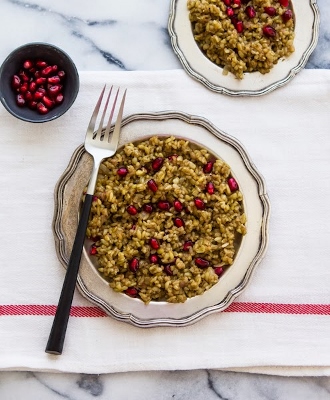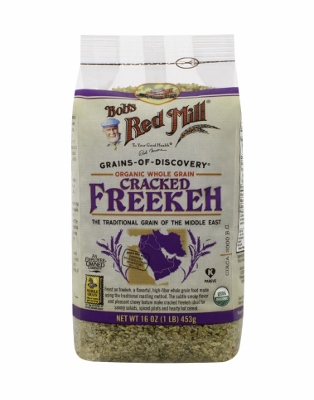What the Freak is Freekeh?
Our latest installment of "What's Up with That Food?"
Photo via Freekeh-foods.com Food FeaturesWhat the freak is freekeh?
Quinoa, which isn’t even technically a grain, hogs the alterna-grain spotlight all the time, with its stores of nutrition, gluten-free status, versatility and quick cooking prowess. Ancient grains are all the rage these days as people try to move beyond rice, oats and yes, quinoa, to experiment with the likes of millet, farro and so forth. Freekeh (pronounced freak-uh) is wheat, so it isn’t gluten-free, but its uses are myriad, and so are its health benefits.

Courtesy of Dalia’s Kitchen
A.K.A.: Farik, frikeh
Type of Food: Grain
Origins: The name comes from a process meaning “to rub” in Arabic, and the food has long been consumed in the Middle East and northeastern Africa.
Why did we start eating it: Freekeh’s got a fiery history. According to legend, a farmer’s crop of young green wheat caught on fire—the work of malicious intent, they say, by a neighboring farmer. Not wanting to waste anything, the farmers harvested the roasted wheat, removed the chaff and uncovered a nutty, slightly smoky flavor.
How it’s used: The sky is the limit here. Swap it out in places where you’d use brown rice or barley. Freekeh cooks relatively quickly—in about 20-25 minutes—and is ideal for weeknight dinners. Toasting it beforehand in a dry skillet over medium heat for a few minutes brings out its roasty notes. Elevate it to a main course by consuming it cold, as in a grain salad with greens or veggies, or hot, first thing in the morning, with fruit and yogurt.
Sarah W. Caron, co-author of the recently published cookbook Grains as Mains, particularly loves it as a substitute for fried rice. The book features a recipe for chicken-fried freekeh (which is a riff on fried rice, not the Texas staple, chicken-fried steak). “It’s totally delicious when I am craving some Chinese food,” she says. Elsewhere in the book, you’ll find freekeh playing a role in paella, arancini, pilaf and a Moroccan lamb stew.
Dalia Dogmoch Soubra, a Syrian celebrity chef based in Dubai and food editor for Harper’s Bazaar Arabia, grew up in Paris to Syrian parents who used it in traditional dishes such as lamb stew or stuffed chicken. It can go Italian, too. “I especially love it in my freekeh and pomegranate risotto,” she says. She, too, likes it cold, used in grain salads such as tabbouleh or fattoush.
How to purchase: You can usually find freekeh in the bulk bins at some grocery and health food stores. Long-running and beloved arbiter of grains and beans, Bob’s Red Mill sells 1-pound bags of organic cracked freekeh grown in the United States, as part of its “Grains of Discovery” line. This variety, in which the kernel is cracked, is what you’re likely to encounter more frequently, but you may see “whole berry” frekeeh. The difference? It’s somewhat akin to the difference between rolled and steel-cut oats. The cracked variety cooks in the time we quoted here, whereas whole berry frekeeh can easily take twice as long.
Sensory experience: It has a smoky, earthy and nutty flavor. Chef Matthew Robinson of The Culinary Exchange calls it “fire-roasted bulgur,” but frekeeh is greener and darker.
Nutrition and other benefits: Freekeh is a powerhouse. On average, freekeh has 6 grams of protein and 4 grams of fiber per serving and is a good source of calcium, iron and lutein, with a low glycemic index. It’s also believed to be more easily digestible than wheat and offers a prebiotic benefit vis-à-vis the amount of lactobacilli, according to Shari Portnoy, R.D.
A word to the wise: It seems that freekeh is volatile, even when you cook it. “Use a bigger pan than you think you need when cooking freekeh. The first time I made it, it boiled over uncontrollably, so now I cook it in a big, big pot,” says Caron. As for storage, like many of its grains, Bob’s Red Mill recommends you keep it in the refrigerator or freezer.
Carrie Havranek is a recovering music critic and part-time baker who writes about food, farmers’ markets, chefs and restaurants—and sometimes travel—from her home in Easton, Pennsylvania. You may have seen her work elsewhere in Edible Philly, the Kitchn, or Frommer’s.
